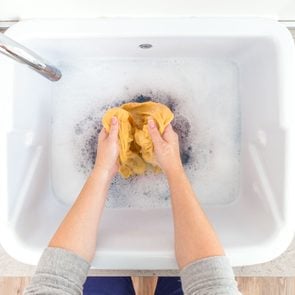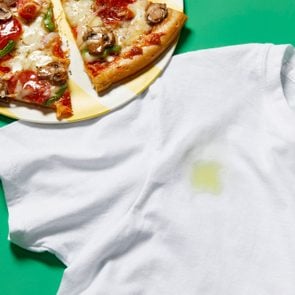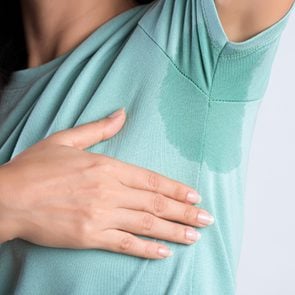How to Use Vinegar in Laundry to Eradicate Smells and More
Updated: Apr. 18, 2024
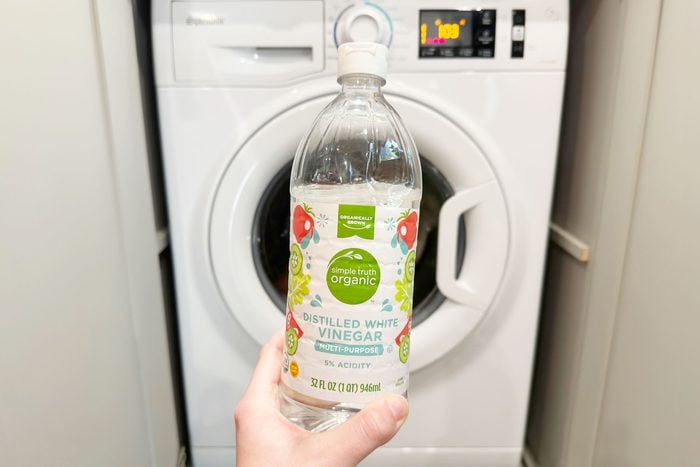
If you’re not using vinegar in laundry, you’re missing out! Here’s how to get fresher, softer, brighter clothes—naturally.
If you’ve ever looked online for cleaning hacks, then you’ve probably come across the tip to use vinegar in laundry. It was something that I’d seen for years, and I have to admit, I put off trying it because I was worried about my clothes smelling like pickles when they came out of the wash. But after I tried it, I realized how much I had been missing—and how the vinegar smell totally dissipated in the machine. Not only that, but my clothes smelled fresher and looked better.
Years later, I actually like the smell because I associate it with “clean.” And as a cleaning professional who’s helmed the Clean Mama website for 15 years, I love the fact that it’s natural, safe and incredibly effective for everything from deodorizing to softening clothing. Now, I recommend it all the time when I teach people how to do laundry the right way.
Ahead, I’ll show you exactly how to clean various laundry items with vinegar, with incredibly simple step-by-step directions. Trust me: This one-ingredient wonder will totally transform your towels, sweaters, socks, jeans and so much more. And no pickle-jar smells—I promise!
Get Reader’s Digest’s Read Up newsletter for more humor, cleaning, travel, tech and fun facts all week long.
| Reviewed for accuracy by: Mary Marlowe Leverette, a highly regarded fabric-care, stain-removal and housekeeping expert with more than 40 years of experience. |
Is it OK to put vinegar in laundry?
Absolutely! In fact, vinegar is the secret weapon that many cleaning experts use to get super soft clothes—naturally. Store-bought fabric softeners and dryer sheets typically contain chemicals that make fabrics “softer,” but what they really do is coat the fibers, creating buildup and preventing water and detergent from actually cleaning them properly. Some health experts also worry about issues ranging from skin irritation to potential carcinogens. You can avoid all of that with vinegar. Plus, it removes product and mineral buildup, which truly makes fibers soft.
Vinegar’s other huge benefit? Removing stinky odors and freshening laundry—again, naturally and thoroughly instead of masking smells the way fragranced products can.
One important note: You should use distilled white vinegar in your laundry, not cleaning vinegar or apple cider vinegar. Distilled white vinegar typically has an acid level of 5%, which is optimal for laundry. Cleaning vinegar has a higher acidity that can harm the inner workings of your washing machine, while apple cider vinegar won’t clean your clothes as effectively and may even stain them.
How to use vinegar in laundry
Before you start throwing vinegar at every laundry problem, you need to know a few things—namely, how and when to add it to your loads. Scroll below to find your specific challenge and the directions you’ll need.
To remove mildew and other odors
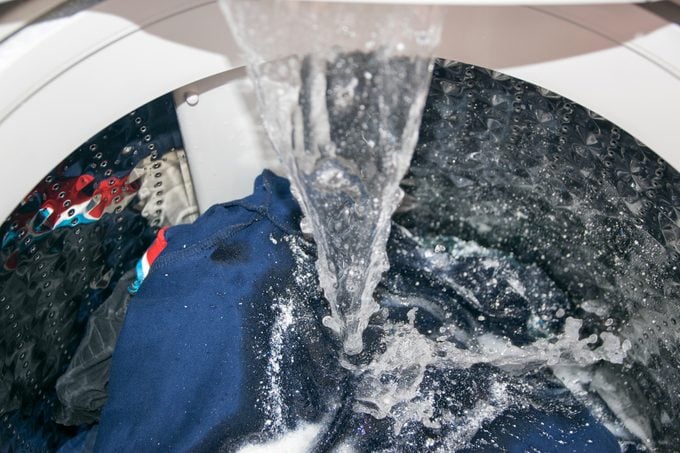
Vinegar is a great mildew and odor remover, especially for smelly towels or a load of laundry that didn’t get put into the dryer right away. It will remove any sour smells—and add an extra cleaning boost—much better than simply running another load will.
- Fill the washing machine with hot water.
- Add 1 to 2 cups of white vinegar directly to the washer. I’ve found that this works best, but you can add it at the beginning of the load if you’re not able to stop the washing machine mid-cycle.
- If you have washing soda on hand, add 1 cup to the hot water for a deep clean.
- As long as the care tag on your items allows it, I recommend using warm/hot water for the first cycle. And if you have a soak cycle, go ahead and use it as well.
- Next, repeat the wash cycle on warm/hot water with your favorite laundry detergent.
- Dry your items as usual, making sure to air-dry or machine-dry properly to avoid creating mildew smells at this stage of the process.
To soften fabric
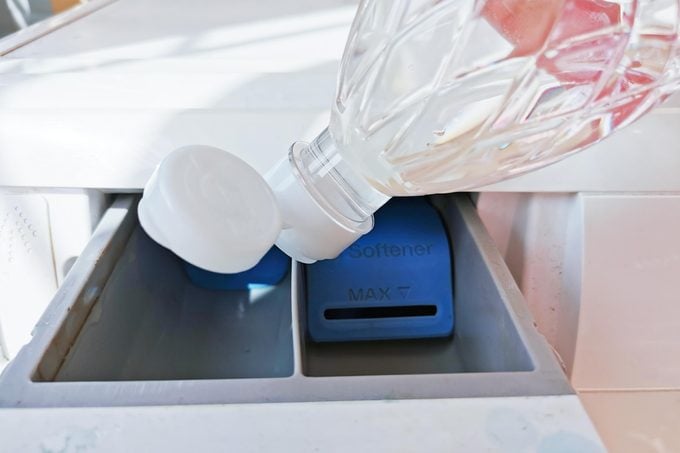
I particularly like using vinegar in laundry to soften towels and sheets. In case you didn’t know, you shouldn’t use conventional fabric softener on towels because it coats the fibers and makes them less absorbent, not to mention harder to get clean.
- Load up your laundry, making sure you aren’t overfilling the machine. You want to ensure that items can freely circulate in the washer (and dryer later on).
- Add your favorite detergent and 1/4 cup of white vinegar to the fabric-softener dispenser or a fabric-softener ball.
- Run your cycle at the setting and temperature noted on the care tag of your garment.
- Dry as usual.
To remove stains
Vinegar isn’t my first choice for a stain remover because it doesn’t have surfactants in it—which is what you need remove many common stains. But it does work great on thicker stains that need to be broken down, like deodorant stains or protein-based food stains; you’ll then follow up with a surfactant to complete the process.
- Wet the stain with warm water, flushing it from back to front so you don’t embed it further in the fibers.
- Pour a small amount of vinegar over the stain (just enough to cover it).
- Use a small, soft textile brush or a repurposed toothbrush to loosen up the stain. Take care to rub carefully so you don’t pill the fabric.
- After a little loosening, add a drop of Castile or dish soap, and continue to work on the stain with the brush. This will help remove and dissolve any remaining stains.
- Run warm water from the back of the stain, rinsing thoroughly.
- If the stain remains, repeat Steps 2–5.
- Once the stain is gone, launder as usual.
| ♦ Pro tip |
| Before using vinegar as a stain remover on dark garments, make sure it won’t cause the dye to bleed, says fabric-care expert Mary Marlowe Leverette. “Place a few drops of vinegar on a hidden area, and let it sit for five minutes,” she advises. “Blot the fabric with a white paper towel. If any color transfers to the towel, it isn’t safe to treat the stain with vinegar.” |
To clean your washing machine
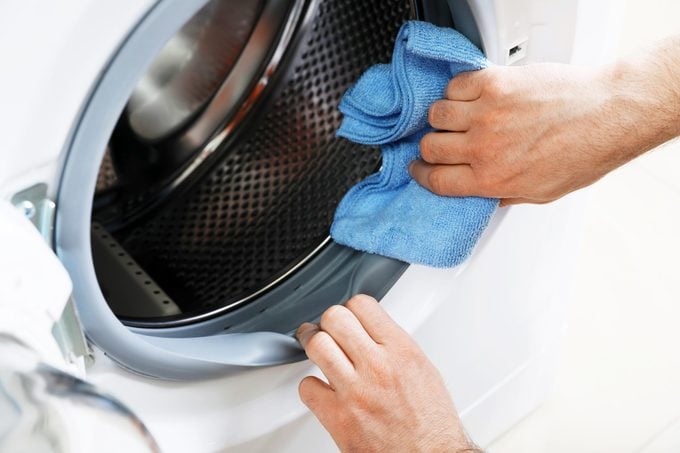
Vinegar is the best thing you can use to clean your washing machine. It removes mineral, detergent and fabric-softener buildup, as well as all sorts of odors. In fact, whenever I have to call a washing-machine repair person, they always comment on how clean my washer is because there’s no buildup. That’s all because of vinegar!
- Empty the washing machine.
- Add up to 4 cups white vinegar directly to the machine.
- Use the “clean washer” cycle on your machine if you have it. If not, run the longest cycle with the hottest water temperature possible.
- Once the cycle is complete, remove any compartments that come out. Use a clean microfiber cloth to wipe them down, along with the inner workings of the machine and the rubber seals.
- Combine white vinegar and water in a 50:50 mixture in a spray bottle. Spray on the exterior of the washing machine, and wipe with a clean microfiber cloth.
To brighten or whiten clothes
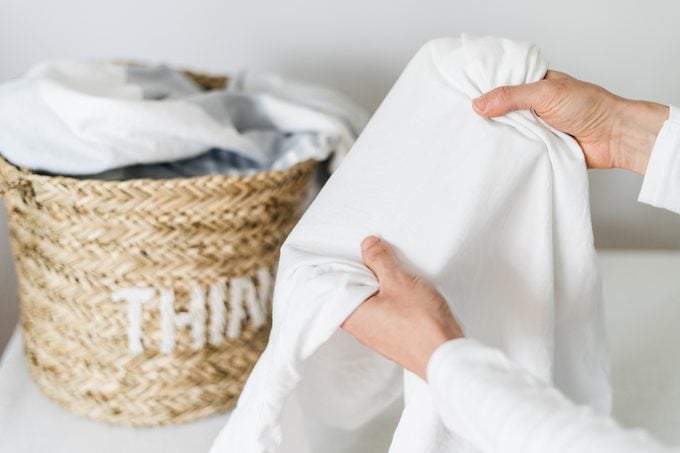
If your clothes are dull or your whites are dingy, try a white vinegar soak instead of reaching for the bleach.
- If you have a soak cycle on your washing machine, use it. This is the easiest option, since everything will be contained in the washing machine and you won’t have to move your laundry again.
- Add 1 cup of white vinegar to the machine, let it fill up with warm water and add your dull clothes. Let them soak for one to two hours. If you have a timed-soak option, use that. If you don’t, you can pause your machine, but check it to make sure it doesn’t automatically drain.
- Run a rinse cycle.
- Then, launder as usual with your favorite detergent.
- Dry items as you normally would.
| ♦ Pro tip |
| If you don’t have a soak-cycle option, fill a bucket or sink with hot water, add 1 cup of white vinegar, and let your items soak for one to two hours. Rinse, and then add the items to your washing machine and run a new cycle. |
When shouldn’t you use vinegar in laundry?
- With chlorine bleach: When mixed with vinegar (or even just hot water), it will create toxic fumes that can be deadly when inhaled at high enough levels. Whatever you do, don’t mix these two items!
- With baking soda: Vinegar and baking soda neutralize each other, so you won’t get the benefits of either if you run them simultaneously. You can, however, add baking soda to your laundry in the wash cycle and white vinegar to the rinse cycle—just don’t add them anywhere together. You also don’t want a fizzing volcano in your washing machine, which is another thing that will happen when you combine these two.
- When washing activewear: You actually can use vinegar on activewear—just very sparingly. The issue? These items contain synthetic fibers, such as nylon and elastane, and vinegar will cause them to break down. While vinegar does neutralize odors in activewear, you won’t need it with every load. Try doing an extra rinse instead!
Alternatives to using vinegar in laundry
Nothing really compares to vinegar, in my opinion. It’s safe, natural and cheap! It’s a great alternative to conventional fabric softeners and whiteners, and it can even be used as a bleach replacement to clean your washing machine. Yes, you can have multiple products to do all of those things, but why? Vinegar gets the job done—and gets it done well.
FAQs
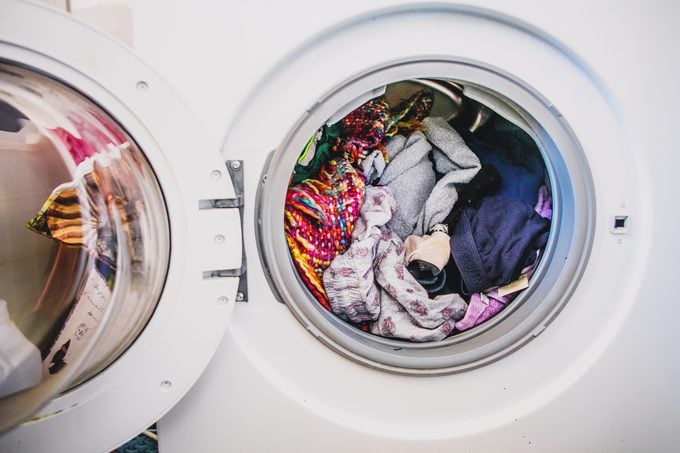
Can I use vinegar and laundry detergent together?
Yes, you can use vinegar and laundry detergent together. See above for the various combinations and methods, but your detergent will take care of the cleaning, while your vinegar will take care of the fabric softening and also give your items an extra cleaning boost.
Is vinegar or baking soda better for laundry?
Vinegar and baking soda do different things in the laundry. Vinegar is more versatile, and since it’s a liquid, it’s easier to use in a washing machine. Baking soda will get rid of odors, but vinegar can do the same thing—and remove minerals too!
Can you put vinegar in the washing machine drawer?
Yes, you can put white vinegar in the fabric-softener drawer. Simply pour it into the drawer, close the drawer and run the cycle. If, for some reason, this doesn’t work for your machine, use a softener ball or pour the vinegar directly in the machine.
Why trust us
At Reader’s Digest, we’re committed to producing high-quality content by writers with expertise and experience in their field in consultation with relevant, qualified experts in the cleaning industry. For this piece on using vinegar in laundry, Becky Rapinchuk, the founder of Clean Mama, tapped her experience as a cleaning expert with more than 15 years of experience, and then Mary Marlowe Leverette, a fabric-care, stain-removal and laundry expert with more than 40 years of industry experience, gave it a rigorous review to ensure that all information is accurate and offers the best possible advice to readers. We verify all facts and data, back them with credible sourcing and revisit them over time to ensure they remain accurate and up to date. Read more about our team, our contributors and our editorial policies.

